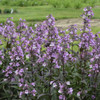Product Description
Penstemon 'Midnight Masquerade' PP29603 - Proven Winners (4) 1-gallons
Common Name: Beardtongue (because sterile stamen has a tuft of small hairs).
Zones 3 to 8.
Full sun.
Plants reach 20 inches tall and 15 to 18 inches wide.
Growth rate: Moderate, erect herbaceous clump-forming perennial.
Rose-purple, trumpet-shaped flowers are borne in profusion on thin spikes in early summer.
Penstemon 'Midnight Masquerade' is a captivating perennial that brings both vibrant color and a touch of drama to sunny gardens. It is a fantastic choice for adding vertical interest, attracting pollinators, and enjoying long-lasting blooms. Here is a closer look at what makes this cultivar special:
Key Features:
- Deep Purple Foliage: 'Midnight Masquerade' stands out with its stunning, deep burgundy-purple foliage. The dark color is most pronounced in full sun and provides a striking contrast to the vibrant flowers.
- Showy Flowers: In late spring to mid-summer, tall, sturdy stems emerge, bearing clusters of lavender-purple, trumpet-shaped flowers with pure white interiors. The flowers rise above the foliage, creating a beautiful, multi-dimensional display.
- Compact and Upright Habit: This penstemon forms a sturdy clump, typically reaching 3-4 feet tall and 2-3 feet wide. Its upright habit makes it a great choice for the middle or back of borders.
- Attracts Pollinators: The nectar-rich flowers are a magnet for hummingbirds, bees, and butterflies, adding life and movement to the garden.
- Low Maintenance: 'Midnight Masquerade' is drought-tolerant once established and does not require deadheading. It is also deer and rabbit resistant.
- Adaptable: It thrives in a wide range of conditions, including heat, humidity, and cold winters.
Growing Tips:
- Sunlight: Plant in full sun (at least 6 hours per day) for the best foliage color and flowering. It can tolerate some light shade, but the foliage may become less vibrant.
- Soil: Prefers well-drained soil but tolerates a variety of soil types.
- Water: Water regularly during the first growing season to establish a strong root system. Once established, it is fairly drought-tolerant.
- Hardiness: 'Midnight Masquerade' is hardy in USDA zones 3-8, making it suitable for various climates.
- Maintenance: Remove spent flower stalks to encourage reblooming and maintain a tidy appearance. You can also cut back the plant in late fall or early spring to tidy it up for the winter.
Design Ideas:
- Borders: Plant in groups or drifts to create a bold statement in borders and flower beds.
- Containers: Its upright habit makes it a good choice for container gardening, adding height and drama to patios and decks.
- Meadow Gardens: Combine with other native wildflowers and grasses for a naturalized look.
- Cut Flowers: The long-lasting blooms make excellent cut flowers for bouquets.
(4) 1-gallon containers ready to plant, plants may be trimmed for shipping,
Other Details
The most important part of the plant is its root system. Healthy roots are the foundation of a healthy, vibrant plant. The type of plug container used is based on the specific needs of the plants. Perennials offered as bare root traditionally perform better when planted as bare root.Planted in a specialized mix, potted plants have well established root systems. Top growth stage will vary depending on the current life cycle and time of year when shipped. In Winter and early Spring dormant plants may be shipped. Dormant plants may be planted right away, even before the last frost date.
Most bare root varieties are field grown for at least one season, though Hemerocallis and Hosta are grown for two seasons. The bulk of the soil is removed during the harvesting process and the tops of most varieties are trimmed back to the crown. They are graded, packed in shredded aspen or sphagnum moss and stored in freezers until ready to be shipped.
See our Container Sizes and Bare Root Perennials pages for more information.
Plant information and care is provided in the Overview section, Plant Genus Page and general information is provided in the Planting Care & Guides. Additional questions can be asked on each Plant page.
Plant Spacing: Using the maximum mature spread or width of a plant to guide spacing, ensures space to grow to full size. To fill an area sooner, plant them closer together. Just remember, future thinning or transplanting may be needed.
Water: Keep a close eye on newly planted perennials, especially throughout the first growing year. Most early plant loss is due to too much or too little water!











